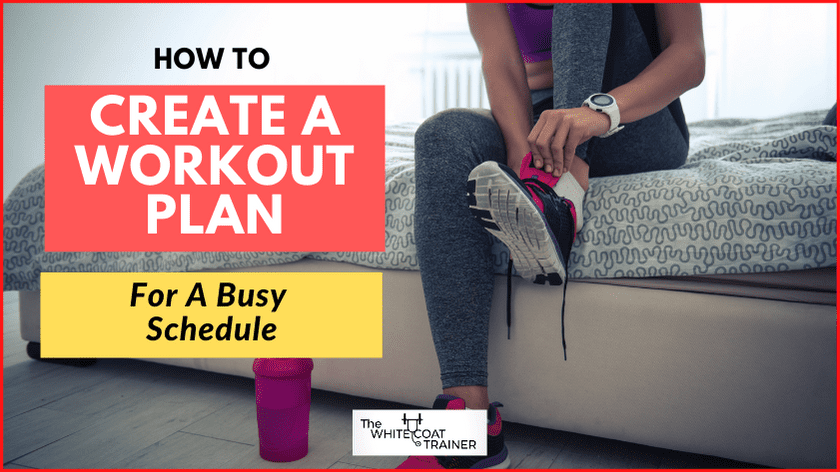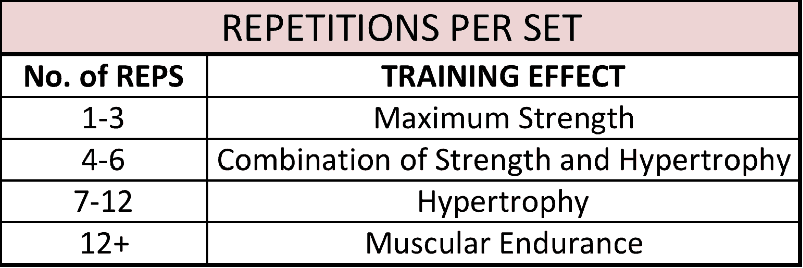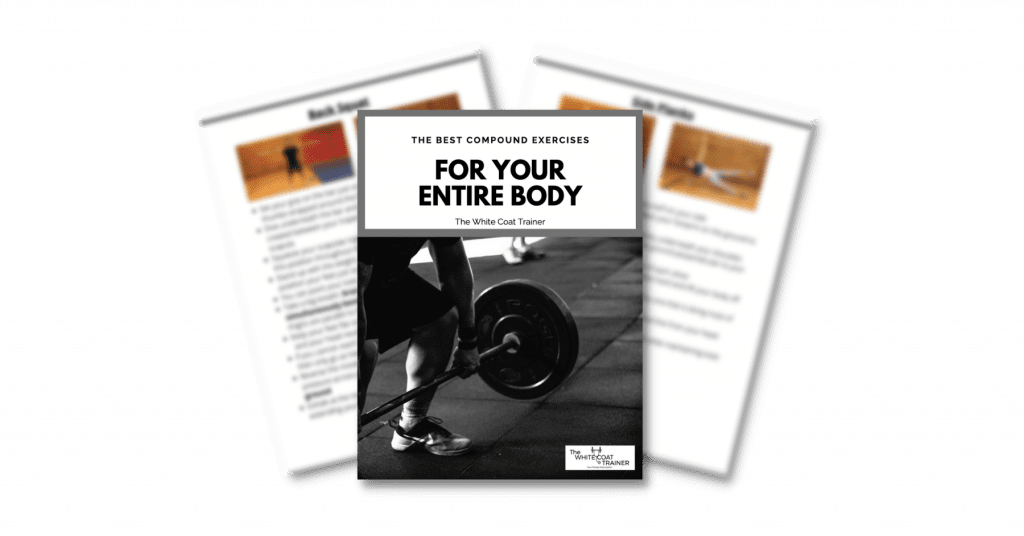This is a complete guide on how to create an effective workout plan, for the gym or at home.
Specifically, you’ll learn:
- What exercises you should perform,
- How many sets and/or reps you should do,
- How to schedule your exercise routine
Let’s dive right in!

How To Create A Workout Plan For Beginners in 3 Steps
When creating a workout plan, there are three things you need to focus on: 1) your workout schedule, 2)exercise selection and 3) your training volume
Let’s go over each step one by one.
Step #1: Creating Your Workout Schedule
When making your workout schedule you need to determine:
- How many days a week you can realistically train, and
- How you are going to divide each training day
To get the most benefits out of your resistance program, it is ideal to work out 3-4 times per week to maximize your results.
With that said, 3-4 times per week might not be possible for you. Your goal should be to work out as often as you can realistically workout. If that’s twice per week, that’s okay.
In fitness, something is ALWAYS BETTER THAN NOTHING.
Either way, each workout should be divided by movement patterns and not by body part.
In general, there are two overarching movement patterns for the upper body.
- The Push
- The Pull
Similarly, there are two overarching movement patterns for the lower body.
- The Knee Flexion
- The Hip Extension
When dividing up your workouts, you have three options:
- You can choose to divide your workout into upper body days and lower body days.
- Alternatively, you can choose to train full body each day, in which you combine movements from both the upper body and lower body in a single training session.
- Lastly, you can choose to train push exercises on one day, pull exercises on another day, and lower body exercises on another.
I go over all three of these training splits in a lot more detail in my post: The 3 Best Workout Splits For Your Training Schedule.
What is a good workout schedule?
If you can train 3 days a week, a good schedule looks like this:
- Monday: Full Body Training Session
- Tuesday: Rest Day
- Wednesday: Full Body Training Session
- Thursday: Rest Day
- Friday: Full Body Training Session
- Saturday: Rest Day
- Sunday: Rest Day
Alternatively, a good 4 day a week schedule can look like this:
- Monday: Upper Body Training Session
- Tuesday: Lower Body Training Session
- Wednesday: Rest Day
- Thursday: Upper Body Training Session
- Friday: Lower Body Training Session
- Saturday: Rest Day
- Sunday: Rest Day
Step #2: How To Select The Best Exercises For Your Workout Plan
To make your workouts effective and efficient, you need to train using the best exercises.
The majority of your training should center around compound functional exercises. Of all the exercises available, there are 4 that give the most benefit in the least amount of time.
The 4 patterns are…
1) THE SQUAT PATTERN
Squatting variations represent the knee flexion movement category. This exercise is the best way to train almost all of the muscles in your lower body, at one time.
You don’t have to do the standard barbell squat either. There are numerous variations of this exercise that you could perform to reap its benefits.
Why is the Squat a Necessary Exercise?
The squat also trains a key functional movement pattern: your ability to rise from a seated or crouched position.
Your workout plan must include some variation of the squat. Check out our squat tutorial here to learn the basic barbell squat.
2) THE HIP EXTENSION PATTERN
The next most important exercise to include in your workout plan is a hip-hinge exercise.
The most common hip-hinge is the deadlift exercise.
The deadlift trains the hips, hamstrings, glutes, spinal erectors, core, and back muscles simultaneously.
No other exercise trains more muscles than this movement pattern. This is by and large the most efficient exercise you could do.
There are numerous deadlift variations you could perform that all serve the same hip-hinge purpose.
Why is the Hip-Hinge a Necessary Exercise?
The hip-hinge teaches you the correct way to pick up an item off the floor without throwing your back out.
Check out our deadlift tutorial here to learn the basic conventional barbell deadlift.
3) THE UPPER BODY PUSH PATTERN
Now we move on to the upper body.
The large muscles of the anterior torso primarily function to push things away from you.
These muscles are the anterior shoulders, the medial shoulders, the pectoralis muscles, as well as the strong triceps muscles behind your arms.
Why is The Upper Body Push A Necessary Exercises?
The push pattern is critical because it strengthens the shoulder joint in a stable position, helping to decrease shoulder dislocations and other shoulder injuries.
It is also important in helping brace a fall, or push you up off the floor if you have already fallen.
Upper body push patterns can be broken up into:
- Horizontal pushing exercises; such as push-ups, dumbbell pressing, and all bench press variations,
- Vertical pushing exercises such as overhead pressing and incline pressing variations.
4) THE UPPER BODY PULL PATTERN
The corollary of pushing is pulling. The back is comprised of many different muscles, all of which can be trained through a variety of pulling exercises.
Pulling exercises also help restore the natural posture of your shoulders and upper spine.
Why is the Upper Body Pull a Necessary Exercise?
Pulling exercises train your ability to pull objects towards you. These muscles are often underdeveloped in many people as this is a movement we don’t readily do in normal everyday activities.
The best pulling exercises include all types of rowing exercises.
Like the upper body push, you can pull in a horizontal and a vertical plane.
- Horizontal pulling exercises; such as dumbbell rows, cable rows, and all bodyweight rows
- Vertical pulling exercises such as pull-ups and pulldowns.
In combination, these 4 exercises will train almost all major muscle groups in your body while teaching important human functionality.
To see a complete list of all the exercises that fall into one of these movement categories, check out my post: The Complete List of Compound Exercises
Alternatively, you can check out our ebook that lists all of the exercises and how to do them properly.
Now that we have the foundational exercises selected, let’s talk about how much of each you should perform.
Step 3: How Much Should You Train Each Workout?
The next thing your fitness plan needs is proper training volume.
The beauty of exercise is that you can perform different amounts of repetitions to obtain different desired effects.
Here are the general guidelines you should follow when creating a workout plan.
How many reps should you do?

For busy professionals, I recommend sticking to the Hypertrophy range for most of your training (at least 75% of the time) to build muscle size quickly.
As you get stronger and gain more experience, you can use the combination rep range for building muscle and strength.
However, you should ensure that you have learned proper form before hitting weights in the 4-6 repetition range.
Lastly, do not practice in the maximum strength range until you have been training consistently for at least 8-12 months.
I go over this in a lot more detail in How Many Sets & Reps You Should Do For The Best Results.
How many sets should you do?
For the most part, you should aim to accomplish anywhere between 20-40 total repetitions per exercise, in approximately 3-6 sets.
For example, If you are performing 8 repetitions, you can do anywhere from 3-5 sets to be in the 20-40 rep range.
Here are the general guidelines
- 40+ Reps- Very High Volume: Burns the most calories. Works best with the Endurance and Hypertrophy rep ranges
- 30+ Reps– High Volume: Burns fewer calories but induces muscular growth and toning. Works best with the Hypertrophy rep range
- 20+ Reps- Moderate Volume: Burns even fewer calories but induces strength and muscle development. Works best with Combination Rep Range
- <20 Reps- Low Volume: Suitable mainly for strength development. Works best with the Combination and Maximal Strength rep ranges

How long should you workout a day?
As a beginner, your workout should not last longer than 30-40 minutes.
30-40 minutes is ideal because you can:
- train 3-4 compound movements per training session
- perform at least 20 repetitions of each exercise per day
- get a good exercise stimulus without fatiguing your body
- realistically stick to this training program even with a busy schedule
I go over more details in How Long Should A Workout Session Be?
Putting It All Together: Creating A Workout Plan Template
Okay, so now you know the best workout schedules, the best exercises, and the best rep ranges.
To help you put it all together, I created this strength training workout plan template that you can download for free.
But before you get started, here are some important things you need to consider:
Start with the basics
Do not get distracted by the latest and greatest exercise machines and fancy workout equipment.
As a beginner, you should focus on the basics.
This means that you should stick to the 4 fundamental movement patterns described above.
Don’t worry about random things such as muscle confusion.
As a beginner, your job is to understand the basic exercises and learn how to do them correctly.
Always start slow
You must take your time when you first start training. Do not go all in, 100% effort, right from day 1. You must let your body adapt to your training.
Going “all-out” will make you extreme muscle soreness, increase your risk of injury, and make you unmotivated really quickly.
Take your time. Start slow.
Start easy.
There’s plenty of time to progress up as you gain experience.
Create a balanced routine
Always create a balance between the front side and backside of your body.
This means that you must do an equal amount of pulling exercises and pressing exercises.
You also need an equal amount of flexion exercises and extension exercises.
Doing too much of any one of these movement patterns can lead to muscular imbalances, poor posture, and an increased risk of pain and injury.
Other Related Questions
How To Make A Workout Plan For A Woman
Now let’s talk about how to make a workout plan for women.
The good news is, there aren’t a ton of changes you need to make to the above program.
The key difference is that women generally need more training volume than men.
- On average, women are shorter and weigh less than men. As such, they generally can’t lift as heavy weight and the range of motion will be less. As a result, weight training in women won’t induce as much fatigue as it does in men. This is why more reps and/or more sets are useful.
- Similarly, women can recover faster from an exercise, so they don’t need as much rest time in between sets.
Therefore, women should go into the Endurance Rep Range and stay on the higher side of the Hypertrophy Rep Range for the majority of their training.
How to avoid getting bulky
Unless you are specifically training for size, eating a big calorie surplus, and have a decently high level of testosterone, you will not get bulky.
Getting bulky is very difficult. How many ‘bulky’ women, do you actually see at the gym?

Brittany can squat >200 lbs and deadlift >300 lbs and she is not “bulky”
Women generally don’t have high enough levels of testosterone to pack on large amounts of muscle.
Saying I don’t want to lift weights because I don’t want to get bulky is like saying, I don’t want to bike too much because if I am not careful I might be doing the Tour de France soon.
How can I make a workout plan at home?
Everything that I said above still applies to your home workout.
The best home workout routine should have you train 3-4x per week, following a full-body (or upper-lower) workout split, and focus on strengthening the push, pull, knee flexion, and hip extension movement patterns.
The only thing that is different is the actual exercises you will be performing.
Instead of using external weights, all of the exercises you perform will be done with your body weight.
I have an entire post going over exactly that- Calisthenics For Beginners: How To Get Started.
Should you work out every day?
Beginners should not work out every day.
You can see great results training just three or four times per week provided you train each of the major muscle groups 1-2 times per week.
Excessive training without adequate rest and recovery time can lead to overuse, pain, and injury.
Is working out 5 days a week too much?
5 days per week is the most amount of training you should do as a beginner. After four weekly workouts, there comes a point of diminishing returns.
How can I create a fitness plan for weight loss?
Losing weight is a process that requires you to speed up your metabolism.
In the simplest sense, metabolism is how much energy your body uses up just to stay alive. So even while you sit here and read this, or when you go to sleep later, your body is using up calories.
So how do we speed up our metabolism with exercise?
1. You Need to Increase Your Muscle Mass
- Regardless of your fitness goals, almost everyone can benefit from more lean muscle
- Muscle is more expensive than fat. Your body has to use up more energy to maintain its muscle mass. Muscle is your body’s secret weapon to burning fat.
- Focus on resistance training and large compound exercises to build as much lean muscle as you can.
2. You Need to Supplement Your Workout Plan With The Right Kind of Cardio
- Steady state cardio is not an efficient way to lose weight. It takes up too much time.
- Also, you will never be able to outrun your diet. Instead, you should focus on increasing your muscle mass and performing High Intensity Interval Training 1-2x per week.
- We have written an entire post on this topic at A Superior Form Of Cardio For Weight Loss [The 15 Minute Workout].
Final Words On How to Design An Effective Workout Plan
You now have everything you need to create your own workout plan.
In a nutshell, a
- Al successful workout plan should incorporate some variation of the push, pull, knee flexion, and hip extension exercises.
- The number of sets and reps can be altered to suit your training goals.
- Higher reps will build endurance and hypertrophy, while lower reps will lead to strength development.
- Stick to 3 sets of 7-12 reps for the vast majority of your training to maximize efficiency in your workout routine.
- Women can train similarly to men, just with higher volumes.
Now we turn it over to you.
What is your primary goal for creating your own workout program?
What inspired you to start your fitness journey?
Comment below and let us know!

Alex Robles, MD, CPT / Brittany Robles, MD, MPH, CPT
Alex & Brittany Robles are physicians, NASM Certified Personal Trainers, and founders of The White Coat Trainer: a resource dedicated to improving the health and fitness of busy professionals using time-efficient strategies. Their advice has been featured in My Fitness Pal, Prevention, Livestrong, Reader’s Digest, Bustle, The Active Times, and more. Learn more about them here.

